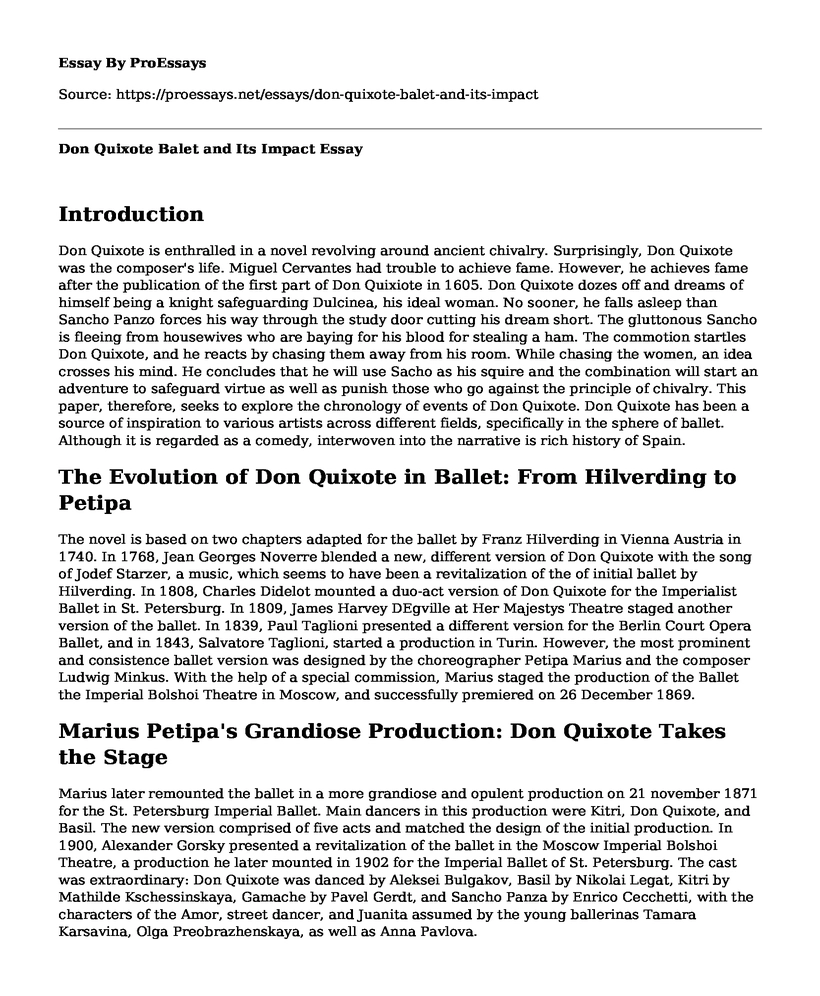Introduction
Don Quixote is enthralled in a novel revolving around ancient chivalry. Surprisingly, Don Quixote was the composer's life. Miguel Cervantes had trouble to achieve fame. However, he achieves fame after the publication of the first part of Don Quixiote in 1605. Don Quixote dozes off and dreams of himself being a knight safeguarding Dulcinea, his ideal woman. No sooner, he falls asleep than Sancho Panzo forces his way through the study door cutting his dream short. The gluttonous Sancho is fleeing from housewives who are baying for his blood for stealing a ham. The commotion startles Don Quixote, and he reacts by chasing them away from his room. While chasing the women, an idea crosses his mind. He concludes that he will use Sacho as his squire and the combination will start an adventure to safeguard virtue as well as punish those who go against the principle of chivalry. This paper, therefore, seeks to explore the chronology of events of Don Quixote. Don Quixote has been a source of inspiration to various artists across different fields, specifically in the sphere of ballet. Although it is regarded as a comedy, interwoven into the narrative is rich history of Spain.
The Evolution of Don Quixote in Ballet: From Hilverding to Petipa
The novel is based on two chapters adapted for the ballet by Franz Hilverding in Vienna Austria in 1740. In 1768, Jean Georges Noverre blended a new, different version of Don Quixote with the song of Jodef Starzer, a music, which seems to have been a revitalization of the of initial ballet by Hilverding. In 1808, Charles Didelot mounted a duo-act version of Don Quixote for the Imperialist Ballet in St. Petersburg. In 1809, James Harvey DEgville at Her Majestys Theatre staged another version of the ballet. In 1839, Paul Taglioni presented a different version for the Berlin Court Opera Ballet, and in 1843, Salvatore Taglioni, started a production in Turin. However, the most prominent and consistence ballet version was designed by the choreographer Petipa Marius and the composer Ludwig Minkus. With the help of a special commission, Marius staged the production of the Ballet the Imperial Bolshoi Theatre in Moscow, and successfully premiered on 26 December 1869.
Marius Petipa's Grandiose Production: Don Quixote Takes the Stage
Marius later remounted the ballet in a more grandiose and opulent production on 21 november 1871 for the St. Petersburg Imperial Ballet. Main dancers in this production were Kitri, Don Quixote, and Basil. The new version comprised of five acts and matched the design of the initial production. In 1900, Alexander Gorsky presented a revitalization of the ballet in the Moscow Imperial Bolshoi Theatre, a production he later mounted in 1902 for the Imperial Ballet of St. Petersburg. The cast was extraordinary: Don Quixote was danced by Aleksei Bulgakov, Basil by Nikolai Legat, Kitri by Mathilde Kschessinskaya, Gamache by Pavel Gerdt, and Sancho Panza by Enrico Cecchetti, with the characters of the Amor, street dancer, and Juanita assumed by the young ballerinas Tamara Karsavina, Olga Preobrazhenskaya, as well as Anna Pavlova.
Don Quixote in the 20th Century: Further Adaptations and Productions
For the 1900 and 1902 productions, Gorsky incorporated new dances. For instance, in the 1900 production, Gorsky introduced new dances to the music by Simon Anton. 1n 1902, when Anton Simon stage the performance in St. Petersburg, the composed Riccardo Drigo created two new versions for Kschessinskaya, the renowned Variation of Kitri with the fan and the Variation of Kitri as Dulcinea. He then adapted the Grand pas des toreadors, a piece that was performed in 1881 by Petipa and Minkus, and which is still incorporated in modern performances of Don Quixote.
The Musical Evolution of Don Quixote: Composers Shaping the Ballet
Don Quixote has indeed influenced ballet composers and choreographers in various parts of the world. Since, the adaptation of the two chapters of the novel, Don Quixote, many ballet composers and choreographers have drawn inspiration from the narrative to enrich or come up with new versions of ballet. It all commences with Franz Hilverding adaptation of the two chapters of the novel to create a Don Quixote ballet in Vienna Austria in 1740. In 1768, Jean Georges Noverre blended a new, different version of Don Quixote with the song of Jodef Starzer. In 1808, Charles Didelot mounted a duo-act version of Don Quixote. . In 1809, James Harvey DEgville at Her Majestys Theatre staged another version of the ballet. Four decades later, Paul Taglioni presented a different version for the Berlin Court Opera Ballet, and in 1843, Salvatore Taglioni, started a production in Turin. In 1869, Marius staged the production of the Ballet the Imperial Bolshoi Theatre in Moscow and later restages the ballet in a more grandiose and opulent in 1869. The incorporation of Don Quixote continue further in 1900s.
Conclusion
The history of Don Quixote is long and remained in Russia even after the 1917 revolution. However, some ballets ceased to be staged after the Soviet period. In fact, it remained one of the permanent repertoire in Moscow Bolshoi Theatre as well as the Leningrad Kirov Theatre. Since its inception, various musicians have helped shape Don Quixote to what it is today.
Cite this page
Don Quixote Balet and Its Impact. (2021, Mar 15). Retrieved from https://proessays.net/essays/don-quixote-balet-and-its-impact
If you are the original author of this essay and no longer wish to have it published on the ProEssays website, please click below to request its removal:
- "Due Process" in The Crucible by Arthur Miller Essay
- 1984 by Orwell and Frankenstein Essay
- Evaluation Essay on Facebook Website
- The Cons of Online Dating Essay Example
- Essay Sample on Single Parenting and Dual Parenting
- Essay Sample on Social Media Marketing: A Growing Trend in Academia
- Oedipus Rex: Fate Reversal and Its Impact on Nemesis - Essay Sample







